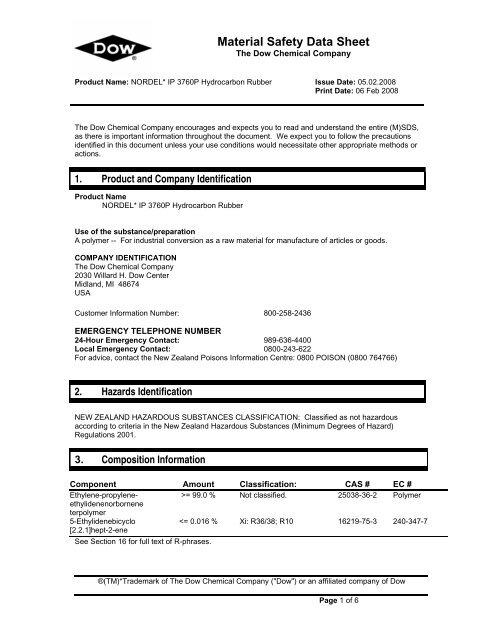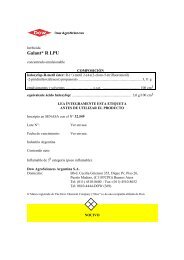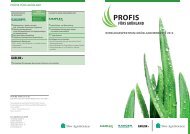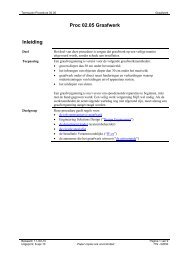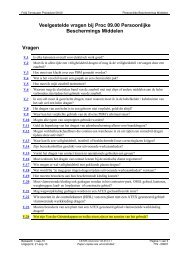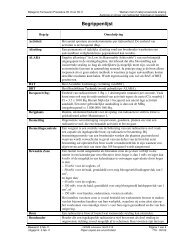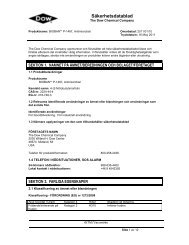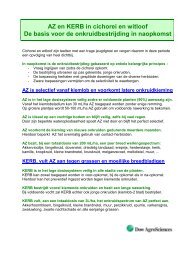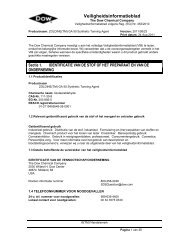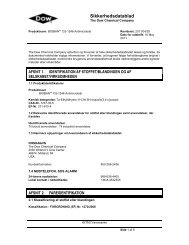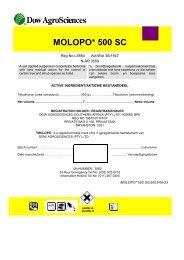Material Safety Data Sheet - The Dow Chemical Company
Material Safety Data Sheet - The Dow Chemical Company
Material Safety Data Sheet - The Dow Chemical Company
You also want an ePaper? Increase the reach of your titles
YUMPU automatically turns print PDFs into web optimized ePapers that Google loves.
Product Name: NORDEL* IP 3760P Hydrocarbon Rubber Issue Date: 05.02.2008<br />
Print Date: 06 Feb 2008<br />
<strong>The</strong> <strong>Dow</strong> <strong>Chemical</strong> <strong>Company</strong> encourages and expects you to read and understand the entire (M)SDS,<br />
as there is important information throughout the document. We expect you to follow the precautions<br />
identified in this document unless your use conditions would necessitate other appropriate methods or<br />
actions.<br />
1. Product and <strong>Company</strong> Identification<br />
Product Name<br />
NORDEL* IP 3760P Hydrocarbon Rubber<br />
Use of the substance/preparation<br />
A polymer -- For industrial conversion as a raw material for manufacture of articles or goods.<br />
COMPANY IDENTIFICATION<br />
<strong>The</strong> <strong>Dow</strong> <strong>Chemical</strong> <strong>Company</strong><br />
2030 Willard H. <strong>Dow</strong> Center<br />
Midland, MI 48674<br />
USA<br />
Customer Information Number: 800-258-2436<br />
EMERGENCY TELEPHONE NUMBER<br />
24-Hour Emergency Contact: 989-636-4400<br />
Local Emergency Contact: 0800-243-622<br />
For advice, contact the New Zealand Poisons Information Centre: 0800 POISON (0800 764766)<br />
2. Hazards Identification<br />
NEW ZEALAND HAZARDOUS SUBSTANCES CLASSIFICATION: Classified as not hazardous<br />
according to criteria in the New Zealand Hazardous Substances (Minimum Degrees of Hazard)<br />
Regulations 2001.<br />
3. Composition Information<br />
Component Amount Classification: CAS # EC #<br />
Ethylene-propyleneethylidenenorbornene<br />
terpolymer<br />
>= 99.0 % Not classified. 25038-36-2 Polymer<br />
5-Ethylidenebicyclo<br />
[2.2.1]hept-2-ene<br />
Product Name: NORDEL* IP 3760P Hydrocarbon Rubber Issue Date: 05.02.2008<br />
4. First Aid Procedures<br />
Eye Contact: Flush eyes with plenty of water; remove contact lenses after the first 1-2 minutes then<br />
continue flushing for several minutes. Only mechanical effects expected. If effects occur, consult a<br />
physician, preferably an ophthalmologist.<br />
Skin Contact: If molten material comes in contact with the skin, do not apply ice but cool under ice<br />
water or running stream of water. DO NOT attempt to remove the material from skin. Removal could<br />
result in severe tissue damage. Seek medical attention immediately.<br />
Inhalation: Move person to fresh air; if effects occur, consult a physician.<br />
Ingestion: If swallowed, seek medical attention. May cause gastrointestinal blockage. Do not give<br />
laxatives. Do not induce vomiting unless directed to do so by medical personnel.<br />
Notes to Physician: If burn is present, treat as any thermal burn, after decontamination. No specific<br />
antidote. Treatment of exposure should be directed at the control of symptoms and the clinical<br />
condition of the patient.<br />
5. Fire Fighting Measures<br />
Extinguishing Media: Water fog or fine spray. Dry chemical fire extinguishers. Carbon dioxide fire<br />
extinguishers. Foam.<br />
Fire Fighting Procedures: Keep people away. Isolate fire and deny unnecessary entry. Soak<br />
thoroughly with water to cool and prevent re-ignition. If material is molten, do not apply direct water<br />
stream. Use fine water spray or foam. Cool surroundings with water to localize fire zone. Hand held<br />
dry chemical or carbon dioxide extinguishers may be used for small fires.<br />
Special Protective Equipment for Firefighters: Wear positive-pressure self-contained breathing<br />
apparatus (SCBA) and protective fire fighting clothing (includes fire fighting helmet, coat, trousers,<br />
boots, and gloves). If protective equipment is not available or not used, fight fire from a protected<br />
location or safe distance.<br />
Unusual Fire and Explosion Hazards: Pneumatic conveying and other mechanical handling<br />
operations can generate combustible dust. To reduce the potential for dust explosions, do not permit<br />
dust to accumulate. Dense smoke is produced when product burns.<br />
Hazardous Combustion Products: During a fire, smoke may contain the original material in addition<br />
to combustion products of varying composition which may be toxic and/or irritating. Combustion<br />
products may include and are not limited to: Carbon monoxide. Carbon dioxide.<br />
See Section 9 for related Physical Properties<br />
6. Accidental Release Measures<br />
Steps to be Taken if <strong>Material</strong> is Released or Spilled: Contain spilled material if possible. Sweep up.<br />
Collect in suitable and properly labeled containers. See Section 13, Disposal Considerations, for<br />
additional information.<br />
Personal Precautions: Spilled material may cause a slipping hazard. Use appropriate safety<br />
equipment. For additional information, refer to Section 8, Exposure Controls and Personal Protection.<br />
Environmental Precautions: Prevent from entering into soil, ditches, sewers, waterways and/or<br />
groundwater. See Section 12, Ecological Information.<br />
7. Handling and Storage<br />
Handling<br />
General Handling: No smoking, open flames or sources of ignition in handling and storage area.<br />
Good housekeeping and controlling of dusts are necessary for safe handling of product. See Section<br />
8, EXPOSURE CONTROLS AND PERSONAL PROTECTION. Avoid breathing process fumes. Use<br />
with adequate ventilation. When appropriate, unique handling information for containers can be found<br />
Page 2 of 6
Product Name: NORDEL* IP 3760P Hydrocarbon Rubber Issue Date: 05.02.2008<br />
on the product label. Workers should be protected from the possibility of contact with molten resin.<br />
Do not get molten material in eyes, on skin or clothing. Pneumatic conveying and other mechanical<br />
handling operations can generate combustible dust. To reduce the potential for dust explosions,<br />
electrically bond and ground equipment and do not permit dust to accumulate. Dust can be ignited by<br />
static discharge.<br />
Storage<br />
Store in accordance with good manufacturing practices.<br />
8. Exposure Controls / Personal Protection<br />
Exposure Limits<br />
Component List Type Value<br />
|<br />
5-Ethylidenebicyclo<br />
[2.2.1]hept-2-ene<br />
ACGIH<br />
NZ OEL<br />
Ceiling<br />
CEILING<br />
5 ppm<br />
25 mg/m3 5 ppm<br />
Although some of the additives used in this product may have exposure guidelines, these additives are<br />
encapsulated in the product and no exposure would be expected under normal handling conditions.<br />
Personal Protection<br />
Eye/Face Protection: Use safety glasses. If there is a potential for exposure to particles which could<br />
cause eye discomfort, wear chemical goggles. If exposure causes eye discomfort, use a full-face<br />
respirator.<br />
Skin Protection: No precautions other than clean body-covering clothing should be needed.<br />
Hand protection: <strong>Chemical</strong> protective gloves should not be needed when handling this<br />
material. Consistent with general hygienic practice for any material, skin contact should be<br />
minimized. Use gloves to protect from mechanical injury. Selection of gloves will depend on<br />
the task. Use gloves with insulation for thermal protection, when needed.<br />
Respiratory Protection: Atmospheric levels should be maintained below the exposure guideline.<br />
When respiratory protection is required for certain operations, use an approved air-purifying respirator.<br />
For emergency conditions, use an approved positive-pressure self-contained breathing apparatus.<br />
<strong>The</strong> following should be effective types of air-purifying respirators: When dust/mist are present use<br />
a/an Particulate filter. When combinations of vapors, acids, or dusts/mists are present use a/an<br />
Organic vapor cartridge with a particulate pre-filter.<br />
Ingestion: Use good personal hygiene. Do not consume or store food in the work area. Wash hands<br />
before smoking or eating.<br />
Engineering Controls<br />
Ventilation: Good general ventilation should be sufficient for most conditions. Local exhaust<br />
ventilation may be necessary for some operations.<br />
Other Information<br />
Selection and use of personal protective equipment should be in accordance with the<br />
recommendations in one or more of the relevant Australian/New Zealand Standards, including:<br />
AS/NZS 1336: Recommended practices for eye protection in the industrial environment.<br />
AS/NZS 1337: Eye protectors for industrial applications.<br />
AS/NZS 1715: Selection, use and maintenance of respiratory protective devices.<br />
AS/NZS 2161: Occupational protective gloves.<br />
AS/NZS 2210: Occupational protective footwear.<br />
AS 2919: Industrial clothing.<br />
9. Physical and <strong>Chemical</strong> Properties<br />
Physical State Pellets or friable bales<br />
Page 3 of 6
Product Name: NORDEL* IP 3760P Hydrocarbon Rubber Issue Date: 05.02.2008<br />
Color Translucent<br />
Odor Odorless<br />
Flash Point - Closed Cup > 240 °C Estimated (setaflash)<br />
Flammable Limits In Air Lower: Not applicable<br />
Upper: Not applicable<br />
Autoignition Temperature No test data available<br />
Vapor Pressure Not applicable<br />
Boiling Point (760 mmHg) Not applicable.<br />
Vapor Density (air = 1) Not applicable<br />
Specific Gravity (H2O = 1) 0.84 - 0.9 Estimated<br />
Freezing Point Not applicable<br />
Melting Point No test data available<br />
Solubility in Water (by Negligible<br />
weight)<br />
pH Not applicable<br />
Kinematic Viscosity Not applicable<br />
10. Stability and Reactivity<br />
Stability/Instability<br />
Stable under recommended storage conditions. See Storage, Section 7.<br />
Conditions to Avoid: Avoid temperatures above 240°C (464°F) Exposure to elevated temperatures<br />
can cause product to decompose. Avoid direct sunlight.<br />
Incompatible <strong>Material</strong>s: None known.<br />
Hazardous Polymerization<br />
Will not occur.<br />
<strong>The</strong>rmal Decomposition<br />
Decomposition products depend upon temperature, air supply and the presence of other materials.<br />
Processing may release fumes and other decomposition products. At temperatures exceeding melt<br />
temperatures, polymer fragments can be released. Fumes can be irritating.<br />
11. Toxicological Information<br />
Acute Toxicity<br />
Ingestion<br />
Very low toxicity if swallowed. Harmful effects not anticipated from swallowing small amounts. May<br />
cause choking if swallowed.<br />
Single dose oral LD50 has not been determined.<br />
Estimated LD50, Rat > 5,000 mg/kg<br />
Eye Contact<br />
Solid or dust may cause irritation or corneal injury due to mechanical action. Vapor may cause eye<br />
irritation experienced as mild discomfort and redness.<br />
Skin Contact<br />
Prolonged contact is essentially nonirritating to skin. Mechanical injury only. Under normal processing<br />
conditions, material is heated to elevated temperatures; contact with the material may cause thermal<br />
burns.<br />
Skin Absorption<br />
No adverse effects anticipated by skin absorption.<br />
<strong>The</strong> dermal LD50 has not been determined.<br />
Estimated LD50, Rabbit > 2,000 mg/kg<br />
Inhalation<br />
No adverse effects are anticipated from inhalation. Vapors/fumes released during thermal processing<br />
may cause respiratory irritation.<br />
Page 4 of 6
Product Name: NORDEL* IP 3760P Hydrocarbon Rubber Issue Date: 05.02.2008<br />
<strong>The</strong> LC50 has not been determined.<br />
Estimated LC50, 1 h, Rat > 20 mg/l<br />
Repeated Dose Toxicity<br />
Based on available data, repeated exposures are not anticipated to cause significant adverse effects.<br />
Developmental Toxicity<br />
For the minor component(s): Did not cause birth defects in laboratory animals. Has been toxic to the<br />
fetus in lab animals at doses toxic to the mother.<br />
12. Ecological Information<br />
CHEMICAL FATE<br />
Movement & Partitioning<br />
No bioconcentration is expected because of the relatively high molecular weight (MW greater than<br />
1000). In the terrestrial environment, material is expected to remain in the soil where it may be subject<br />
to wind dispersion. In the aquatic environment, material is expected to float.<br />
Persistence and Degradability<br />
This water-insoluble polymeric solid is expected to be inert in the environment. Surface<br />
photodegradation is expected with exposure to sunlight. No appreciable biodegradation is expected.<br />
ECOTOXICITY<br />
Not expected to be acutely toxic to aquatic organisms.<br />
13. Disposal Considerations<br />
For uncontaminated material the disposal options include mechanical and chemical recycling or<br />
energy recovery. In some countries landfill is also allowed. For contaminated material the options<br />
remain the same, although additional evaluation is required. For all countries the disposal methods<br />
must be in compliance with national and provincial laws and any municipal or local by-laws. All<br />
disposal methods must be in compliance with the EU framework Directives 91/156/EEC, 91/689/EEC<br />
and their subsequent adaptations, as implemented in National Laws and Regulations, as well as EU<br />
Directives dealing with priority waste streams. Transboundary shipment of wastes must be in<br />
compliance with EU Regulation 259/93 and subsequent modifications.<br />
14. Transport Information<br />
ROAD & RAIL<br />
NOT REGULATED<br />
IMDG<br />
NOT REGULATED<br />
ICAO/IATA<br />
NOT REGULATED<br />
This information is not intended to convey all specific regulatory or operational<br />
requirements/information relating to this product. Additional transportation system information can be<br />
obtained through an authorized sales or customer service representative. It is the responsibility of the<br />
transporting organization to follow all applicable laws, regulations and rules relating to the<br />
transportation of the material.<br />
Page 5 of 6
Product Name: NORDEL* IP 3760P Hydrocarbon Rubber Issue Date: 05.02.2008<br />
15. Regulatory Information<br />
This product is included on the New Zealand list of Notified Toxic Substances (NOTS) or otherwise<br />
complies with the requirements of the Hazardous Substances and New Organisms Act 1996.<br />
Classification and User Label Information<br />
No regulatory requirements known.<br />
<strong>Safety</strong> data sheet available for professional users on request.<br />
16. Other Information<br />
Risk-phrases in the Composition section<br />
R10 Flammable.<br />
R36/38 Irritating to eyes and skin.<br />
Revision<br />
Identification Number: 1010022 / 1001 / Issue Date 05.02.2008 / Version: 1.0<br />
Most recent revision(s) are noted by the bold, double bars in left-hand margin throughout this<br />
document.<br />
Legend<br />
N/A Not available<br />
W/W Weight/Weight<br />
OEL Occupational Exposure Limit<br />
STEL Short Term Exposure Limit<br />
TWA Time Weighted Average<br />
ACGIH American Conference of Governmental Industrial Hygienists, Inc.<br />
DOW IHG <strong>Dow</strong> Industrial Hygiene Guideline<br />
WEEL Workplace Environmental Exposure Level<br />
HAZ_DES Hazard Designation<br />
<strong>The</strong> <strong>Dow</strong> <strong>Chemical</strong> <strong>Company</strong> urges each customer or recipient of this (M)SDS to study it carefully and<br />
consult appropriate expertise, as necessary or appropriate, to become aware of and understand the<br />
data contained in this (M)SDS and any hazards associated with the product. <strong>The</strong> information herein is<br />
provided in good faith and believed to be accurate as of the effective date shown above. However, no<br />
warranty, express or implied, is given. Regulatory requirements are subject to change and may differ<br />
between various locations. It is the buyer's/user's responsibility to ensure that his activities comply with<br />
all federal, state, provincial or local laws. <strong>The</strong> information presented here pertains only to the product<br />
as shipped. Since conditions for use of the product are not under the control of the manufacturer, it is<br />
the buyer's/user's duty to determine the conditions necessary for the safe use of this product. Due to<br />
the proliferation of sources for information such as manufacturer-specific (M)SDSs, we are not and<br />
cannot be responsible for (M)SDSs obtained from any source other than ourselves. If you have<br />
obtained an (M)SDS from another source or if you are not sure that the (M)SDS you have is current,<br />
please contact us for the most current version.<br />
Page 6 of 6


